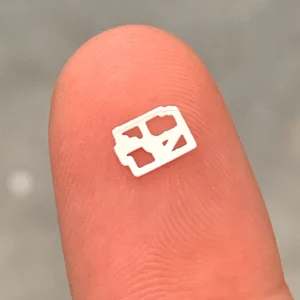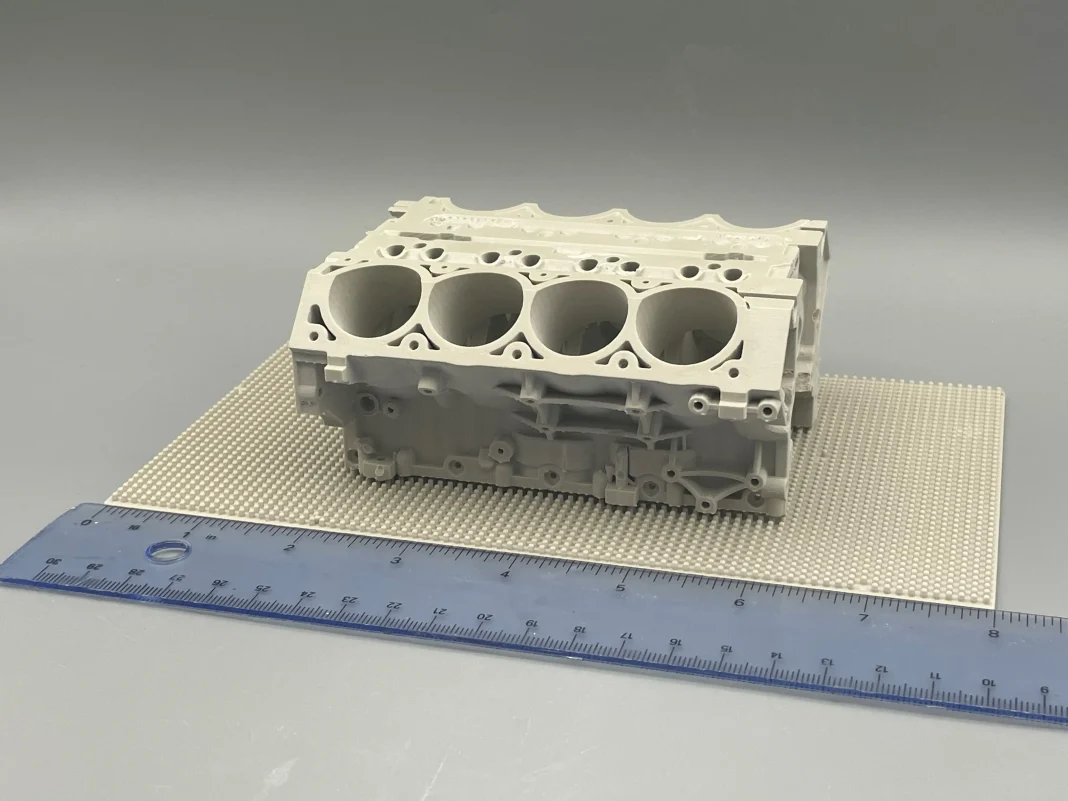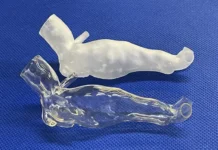By Liz Stevens, writer, UV+EB Technology
Tethon 3D (“Tethon”), of Omaha, Nebraska, is a company on the cutting edge of ceramic 3D printing, offering UV-curable ceramic, metal and polymer resins, ceramic powders and custom-formulated materials. Tethon also sells its own 3D UV printer – the Bison 1000 ceramic DLP printer – and proprietary resins for it.
Poised as a provider for the creation of high-value, highly specialized lower- to middle-run additive ceramic parts, Tethon currently sells materials to over 1,000 customers in 40 countries. And yet, Tethon firmly believes that it has only scratched the surface of its potential reach and impact, characterizing its current clientele as the innovators and early adopters. Tethon works with research institutions, government labs and every branch of the US military. Los Alamos National Laboratory, Idaho National Laboratory and the Honeywell National Security campus are a few of Tethon’s customers doing research on ceramic additive materials. NASA also is a Tethon materials customer, due to the unique thermal properties that ceramics have.
The company has a published US patent for a novel sinterable ceramic resin chemistry that allows for the control of an object’s porosity, a key requirement for producing ceramic resin items. Tethon also stands out for its advanced polymer resin creation science, formulating resins with specialized features such as conductivity, high thermal-shock tolerance and tooth/bone properties. Tethon 3D earned a 2021 RadLaunch Award. Its CEO, Trent Allen, and its CTO, Greg Pugh, spoke with UV+EB Technology about some of the company’s innovations.
UV-Curable Graphenite™, Mullite and Osteolite® Hydroxyapatite
“Tethon 3D got started in the creation of advanced ceramic resins,” Allen explained, “by providing ceramic materials for binder jetting technology. With the invention of 3D printers by Formlabs and other desktop 3D printers, we ventured into the UV polymer side of things, using our powder knowledge to bring a ceramic resin to market.”
One of the company’s resins, Graphenite™ Graphene Resin, which is formulated for its Bison 1000 DLP printer, can be used to produce lightweight objects with great strength and conductivity. Graphene conducts heat and electricity very efficiently along its plane. The material strongly absorbs light of all visible wavelengths, which accounts for the black color of graphite; yet a single graphene sheet is nearly transparent because of its extreme thinness. The material also is about 100 times stronger than would be the strongest steel of the same thickness.1
Tethon has developed an ever-growing array of ceramic resins. “We work with many different suppliers of ceramic powders and materials,” said Allen. “Our goal is to mimic not only the catalogue of traditional ceramic material manufacturers but also the technical properties. For us, expanding our resin portfolio for our customers is of utmost importance.”
Tethon’s Mullite Ceramic Resin, recommended for the Bison 1000 DLP 3D printing platform and requiring sintering to become 100% Mullite, offers low thermal expansion, low thermal conductivity, high temperature strength and good chemical stability. Mullite, a rare mineral consisting of aluminum silicate (3Al2O3·2SiO2), is formed upon firing aluminosilicate raw materials and is the most important constituent of ceramic whiteware, porcelains and high-temperature-insulating and refractory materials.2 Defense and aerospace industries are the primary users of objects made with mullite ceramic resin.
Allen noted that creating a UV-curable ceramic resin poses certain challenges. “Ceramics can absorb, block or scatter UV energy,” he said. “The challenge is around harnessing the UV while keeping the ceramic particles properly suspended in the resin.” Printing, however, is just one of the challenging aspects of using ceramic resins. “Sintering is the main challenge,” Allen continued. “When developing a ceramic resin, you’ll want to increase the load of powder as much as possible to limit shrinkage and possible warpage.” Tethon’s patent for a novel sinterable ceramic resin chemistry comes to the fore in this regard, as described below.
Osteolite® Hydroxyapatite Resin is one of Tethon’s most intriguing resins, developed for SLA/DLP 3D printing and for research use only. Hydroxyapatite is a mineral of the apatite group. It is a ceramic material that forms the mineral phase of bone, composed primarily of calcium and phosphate at a respective ratio of 1.67. Allen stated that Tethon’s Osteolite® Hydroxyapatite Resin potentially could be used as an implantable to help with the regeneration of bone cells.
Explaining the impetus for Tethon’s work with hydroxyapatite, Allen said, “This is another case of ceramic material providers wanting to supply powders for additive manufacturing.” Tethon enjoys a worldwide reputation in ceramic additives and frequently receives powders from material providers. “Hydroxyapatite always has been on our radar, even when our company was mainly focused on aqueous based binder jetting,” he said. “We believe this material and TCP (tricalcium phosphate) are interesting ceramics with many different healthcare applications.”
Novel Sinterable Ceramic Resin Chemistry – patent US10981326B1
 While a typical nonceramic, 3D-printed object is considered complete after a post-printing wash and some final UV curing, a ceramic object requires additional steps and a specially designed resin recipe. After printing, but before its final step of sintering to fuse the ceramic particles together, a method can be employed to remove resin remaining in the interior of the object.
While a typical nonceramic, 3D-printed object is considered complete after a post-printing wash and some final UV curing, a ceramic object requires additional steps and a specially designed resin recipe. After printing, but before its final step of sintering to fuse the ceramic particles together, a method can be employed to remove resin remaining in the interior of the object.
The patent abstract describes Tethon 3D’s novel approach like this: “A three-dimensional printed structure can include a photocurable resin, a sinterable material and a plurality of elongated particles. The elongated particles are distributed within the printed structure. The elongated particles are shaped and distributed to promote porosity control (e.g., improved densification) within the structure.”
Tethon 3D holds a patent for a novel sinterable resin chemistry including metal or ceramic particles along with particles that create minute porosity in the resulting ceramic resin objects. During post-process burn-off and/or decomposition – when surface binders usually are eliminated – the porosity created by the elongated particles allows for superior escape of interior-based resin polymer so that, once at the sintering stage, only the fused ceramic particles and the elongated particles remain.
Tethon’s CTO Greg Pugh explained that the particles collapse, melt and/or remain structural throughout the sintering process. “This happens in the same sintering cycle as the polymer resin burning out,” he said, “just at different temperatures throughout the process. The particles remain in the structural body of the ceramics but just change forms through the sintering cycle. This allows for an object to become fully dense (99.9%) after sintering. Some of the particles can act as replacement for the resin matrix, as they go from an elongated particle to glassy matrix.”
The ability to vary the porosity of ceramics yields many advantages, such as the option of creating ceramic objects featuring the lightweight, porous but strong nature of avian bones or the heavy, solid nature of mammal bones. The chemistry and technique also can be used to create a true, pure ceramic with no polymer inclusions. “Ceramics come in many material formulations,” said Pugh. “Our clients have many different needs, and we focus on the ability to control porosity. If they want to increase porosity, we can do that, and if they want to decrease porosity, we can do that as well.”
Breaking new ground in ceramic 3D printing, Tethon 3D is a great resource for the early adopters, the innovators and anyone else pushing the 3D ceramic envelope.







